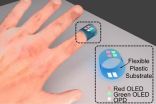(Press-News.org) BERKELEY -- Future fitness trackers could soon add blood-oxygen levels to the list of vital signs measured with new technology developed by engineers at the University of California, Berkeley.
"There are various pulse oximeters already on the market that measure pulse rate and blood-oxygen saturation levels, but those devices use rigid conventional electronics, and they are usually fixed to the fingers or earlobe," said Ana Arias, an associate professor of electrical engineering and computer sciences and head of the UC Berkeley team that is developing a new organic optoelectronic sensor.
By switching from silicon to an organic, or carbon-based, design, the researchers were able to create a device that could ultimately be thin, cheap and flexible enough to be slapped on like a Band-Aid during that jog around the track or hike up the hill.
The engineers put the new prototype up against a conventional pulse oximeter and found that the pulse and oxygen readings were just as accurate.
The research team reported its findings today (Wednesday, Dec. 10) in the journal Nature Communications.
Giving silicon a run for its money
A conventional pulse oximeter typically uses light-emitting diodes (LEDs) to send red and infrared light through a fingertip or earlobe. Sensors detect how much light makes it through to the other side. Bright, oxygen-rich blood absorbs more infrared light, while the darker hues of oxygen-poor blood absorb more red light. The ratio of the two wavelengths reveals how much oxygen is in the blood.
For the organic sensors, Arias and her team of graduate students - Claire Lochner, Yasser Khan and Adrien Pierre - used red and green light, which yield comparable differences to red and infrared when it comes to distinguishing high and low levels of oxygen in the blood.
Using a solution-based processing system, the researchers deposited the green and red organic LEDs and the translucent light detectors onto a flexible piece of plastic. By detecting the pattern of fresh arterial blood flow, the device can calculate a pulse.
"We showed that if you take measurements with different wavelengths, it works, and if you use unconventional semiconductors, it works," said Arias. "Because organic electronics are flexible, they can easily conform to the body."
Arias added that because the components of conventional oximeters are relatively expensive, health care providers will choose to disinfect them if they become contaminated. In contrast, "organic electronics are cheap enough that they are disposable like a Band-Aid after use," she said.
INFORMATION:
The National Science Foundation and Flextech helped support this research.
New Haven, Conn. - A new combination of cancer drugs delayed disease progression for patients with hormone-receptor-positive metastatic breast cancer, according to a multi-center phase II trial. The findings of the randomized study (S6-03) were presented at the 2014 San Antonio Breast Cancer Symposium, held Dec. 6-9, by Kerin Adelson, M.D., assistant professor of medical oncology at Yale Cancer Center and chief quality officer at Smilow Cancer Hospital at Yale-New Haven.
The trial enrolled 118 post-menopausal women with metastatic hormone-receptor-positive breast cancer ...
PHILADELPHIA--Two-thirds of women treated for early-stage breast cancer in the U.S. receive longer radiation therapy than necessary, according to a new study published in JAMA this week from Penn Medicine researchers Ezekiel J. Emanuel, MD, PhD, and Justin E. Bekelman, MD. Their findings reveal that the vast majority of women after breast conserving surgery receive six to seven weeks of radiation therapy, despite multiple randomized trials and professional society guidelines showing that three weeks of radiation - called hypofractionated whole breast radiation - is just ...
Although the use of a type of radiation treatment that is shorter in duration and less costly has increased among women with early-stage breast cancer who had breast conserving surgery, most patients who meet guidelines to receive this treatment do not, according to a study appearing in JAMA. The study is being released to coincide with the San Antonio Breast Cancer Symposium.
Breast cancer accounts for the largest portion of national expenditures on cancer care, estimated to reach $158 billion in 2020. Breast conservation therapy is the most common treatment for early-stage ...
Researchers at Case Western Reserve University School of Medicine have uncovered the mechanism that enables the enzyme Lecithin: retinol acyltransferase (LRAT) to store vitamin A--a process that is indispensable for vision.
"Without this information, our knowledge was inadequate to understand the molecular mechanisms of blindness caused by mutations in the enzyme," said Marcin Golczak, assistant professor of pharmacology at Case Western Reserve and an author of the study.
The researchers hope the new information will be used to design small molecule therapies for degenerative ...
New research reports that liver transplant recipients with less understanding of treatment information and improper use of medications may be more likely to have trouble following the prescribed regimen. According to the study published in Liver Transplantation, a journal of the American Association for the Study of Liver Diseases and the International Liver Transplantation Society, the patients' non-adherence is linked to adverse clinical outcomes, such as organ rejection or graft loss.
During the past 30 years, improvements in surgical techniques and advances in immunosuppressive ...
Reductions in government healthcare spending in the European Union (EU) are associated with increased maternal mortality rates, suggests a new paper published today (10 December) in BJOG: An International Journal of Obstetrics and Gynaecology (BJOG). However, if skilled birth attendants are in place, the association disappears, highlighting the potential importance of maternal care, finds the research.
The study looks at the association between reductions in government healthcare spending (GHS) and maternal mortality across the European Union (EU) over a 30 year period ...
WASHINGTON - The correlation between Internet searches on a regional medical website and next-day visits to regional emergency departments was "significant," suggesting that Internet data may be used in the future to predict the level of demand at emergency departments. The first study to use Internet data to predict emergency department visits in either a region or a single hospital was published online Friday in Annals of Emergency Medicine ("Forecasting Emergency Department Visits Using Internet Data") .
"Website visits may be used to predict ER visits for a geographic ...
Hair loss can be devastating for the millions of men and women who experience it. Now scientists are reporting that a substance from honeybee hives might contain clues for developing a potential new therapy. They found that the material, called propolis, encouraged hair growth in mice. The study appears in ACS' Journal of Agricultural and Food Chemistry.
Ken Kobayashi and colleagues note that propolis is a resin-like material that honeybees use to seal small gaps in their hives. Not only does it work as a physical barrier, but it also contains active compounds that fight ...
Cigarette smoking generates as much as $170 billion in annual health care spending in the United States, according to a new study co-authored by researchers at Georgia State University's School of Public Health, the Centers for Disease Control and Prevention (CDC) and RTI International.
Dr. Terry F. Pechacek, a professor of health management and policy at Georgia State, was the senior author of the study, "Annual Healthcare Spending Attributable to Cigarette Smoking (An Update)," which was published Wednesday by the American Journal of Preventive Medicine.
The study ...
Touch can be a subtle sense, but it communicates quickly whether something in our hands is slipping, for example, so we can tighten our grip. For the first time, scientists report the development of a stretchable "electronic skin" closely modeled after our own that can detect not just pressure, but also what direction it's coming from. The study on the advance, which could have applications for prosthetics and robotics, appears in the journal ACS Nano.
Hyunhyub Ko and colleagues explain that electronic skins are flexible, film-like devices designed to detect pressure, ...

